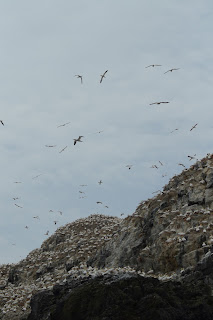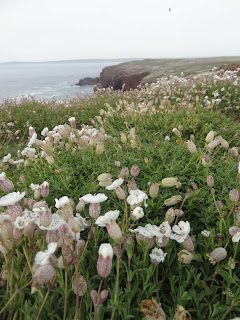Razorbill
Puffin (a "silver-back" perhaps indicative of an old bird)
Wheatear passage was evident throughout the island (which also led on to a productive breeding season) whilst the last of the winter visitors including Hen Harrier, Sparrowhawk and Merlin made a final few appearances. Wader passage also revealed good numbers of Whimbrel, a few Curlew, Turnstone, Snipe, Dunlin, Greenshank, Common Sandpiper and Ringed Plover. The only resident wader, Oystercatcher also became increasingly aggressive as their breeding season began and two pairs each of Raven and Chough nesting on the island provided some drama.
Whimbrel
Raven
Passerine passage included a modest number of Chiffchaffs, Willow Warblers, Blackcaps, Sedge Warblers, lesser numbers of Goldfinch, Linnet and Lesser Redpoll whilst residents such as Reed Bunting, Skylark, Meadow Pipit, Rock Pipit and Wren became ever more vocal and apparent. Highlights for the first month included migrant Black Redstarts, Redstart, Stonechat, Water Rail, Marsh Harrier and the first White Wagtails of the year. Seawatching produced a few Common Dolphins and Harbour Porpoise as well as occasional Red-throated Divers, Great Northern Divers, Bonxies, Common Scoter, Sandwich Terns, Arctic Terns and a few "commic" terns. Hirundine passage was also evident with large numbers of Swallows interspersed with a few House Martins and Sand Martins for much of the spring.
Much time was also spent constructing numerous Strom Petrel nest boxes, consuming a lot of hours and involved an equal amount of hard labour but proved exceedingly rewarding. An evening visit to the quarry produced dozens/hundreds of Storm Petrels and even a Short-eared Owl hunting them.
Nicci, a fellow spring long-term volunteer found the first rarity highlight of the year, a stunning male EASTERN SUBALPINE WARBLER. It was trapped shortly after being found and proved an extremely educational bird. Before the month was even up, a surprise Brent Goose flew past me along the south coast. Fortunately it came to land in a Lesser Black-backed Gull colony on the other end of the island and despite other birders obtaining decent views of it, racing it proved considerably more difficult (see pic on the Skokholm Blog 26/03/16). A Dark-bellied Brent Goose also appeared on the island at the end of the month. Hearing Whimbrel singing was another valuable experience as was picking out the Greenland Wheatears from the nominate individuals.
May provided many enjoyable birding experiences too with regular appearances of Short-eared Owls (crossing Broad Sound from Skomer to hunt the island Storm Petrels at night). Three Turtle Doves also appeared during the month as did a few Whinchats, Firecrest, a Little Egret, occasional wandering Kestrels, and a modest spring passage of Spotted Flycatchers. Pied Flycatcher also occurred. Seabird work soon took the forefront as we began our Manx Shearwater study plot counts and nest recording Great Black-backed Gulls. Further spring migrants gradually appeared including Garden Warblers, Cuckoo and 2 Arctic Skuas. The 11th May conjured up two surprises, first up a drake Pochard in Crab Bay (an island rarity), shortly followed by a stunning Golden Oriole which burst from the Well before flying east across The Neck. A second Subalpine Warbler appeared on the 13th May (this time a female Western/Moltoni's still to be DNA confirmed). The following day produced yet another male Eastern Subalpine Warbler and an overdue Tree Pipit! A Red-veined Darter on the 15th May was the only ordonata I saw whilst on the island but at least it was a lifer!
Red-veined Darter
By mid-May the seabird work was well underway with much attention diverted to the Lesser Black-backed Gull colonies, counting incubating Herring Gulls around The Neck and ringing Great Black-backed Gulls. Fulmar study plots were visited daily and the reading of Puffin colour rings in Crab Bay also kept us all entertained for many hours.
Lesser Black-backed Gull
One of my personal highlights was finding a female Red-backed Shrike in the Well heligoland trap and a flyover Osprey the following day. The rest of May offered the occasional stunning summer plumage Golden Plover, Ruff, Redshank, two nesting pairs of Peregrine, nesting Buzzard, 2 sub-adult Pomarine Skuas on seawatch and a brilliant opportunity to observe the island nesting seabirds from the sea as we conducted our full island auk count from a RIB. The first record of nesting Reed Warblers for the island was an exciting discovery in the small reedbed at the Well. I was also given the opportunity to visit Grassholm, which hosts an impressive colony of c36,000 pairs Gannets, an awesome spectacle!
From mid-June onwards the staff and myself embarked on a full island Storm Petrel census. This involved playing a recording into every single suitable crevice across the island to elicit the number of responses gained across the entire 1 square km area of the island, including every stone wall, every accessible geo, cave and bolder slope. This proved a large task but fortunately the vast majority was achieved before I left the island on the 11th July.
By late June-July flocks of Kittiwakes and Gannets could be seen regularly passing the island. An adult Gannet on the rocky bolder beach at the bottom of Peter's Bay was also a surprise encounter. The first Pufflings also appeared (often in the mouths of Great Black-backed Gulls) and two visits to The Neck were made to count the number of juvenile Herring Gulls raised during the season.
During my stay I also had the opportunity to ring Manx Shearwaters along the study transect and birds from study burrows above Crab Bay and around the lighthouse, ring a few Razorbill chicks around The Bluffs bolder fields, colour ring Puffins in Crab Bay and help with the ringing activities around the obs. I also caught up with the rare form of Scarlet Pimpernelle (the Blue Pimpernelle), Three-lobed Crowfoot (another rarity) and two spikes of Southern Marsh Orchid at the bottom of Well Stream. A few butterflies were also on the wing including a Painted Lady, Common Blue, Green-veined White, Large White, Small Copper, Red Admiral, Peacock and Meadow Brown.
Blue Pimpernelle
Finally, a big thanks must go to the wardens Richard and Giselle and the volunteers, Nicci, Vicky, Phil and Olivia for the great company and an amazing experiences we shared together!
Skokholm






















Hi Sam, just seen this post which brings back happy memories of our visit to Skokholm in 2014.
ReplyDeleteBtw the book that I was trying to remember was Down and Dirty Birding by Joey Slinger. All the best, Steve